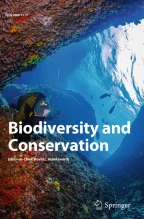1455Accesses
42Citations
3 Altmetric
Abstract
Protected areas are key to conservation of biodiversity, and Australia is one of the world’s megadiverse regions. Monitoring programs provide the information to assess the state of conservation resources, the severity of threats and the success of management responses. Here we compare the management priorities, monitoring priorities and actual monitoring practices of protected area management agencies in Australia, using four sets of data at continental scale and five at a more restricted regional scale. We track changes over a period of several years and focus at successively finer levels of detail. At both continental and regional scales, most management plans emphasise fire, invasive species and visitor management; and most monitoring programmes refer to visitor numbers and impacts as well as species and ecosystems. There is only a weak match, however, between reported management priorities and actual monitoring programmes; and the effectiveness of management responses is rarely monitored. The level of detail in visitor monitor programmes varies considerably: most parks count visitors, but few know what those visitors do. Threats from fire and invasive species receive more attention that those from recreation. At regional scale, the proportion of parks with defined monitoring programmes and priorities increased significantly from 2003/2004 to 2006/2007. Whilst only a proportion of protected areas monitor endangered species populations, for those that do this is the parameter reported in most detail, with many parks reporting single records of single individuals. Some parks also maintain anecdotal records of rare species outside routine monitoring programs.
This is a preview of subscription content,log in via an institution to check access.
Access this article
Subscribe and save
- Starting from 10 chapters or articles per month
- Access and download chapters and articles from more than 300k books and 2,500 journals
- Cancel anytime
Buy Now
Price includes VAT (Japan)
Instant access to the full article PDF.
Similar content being viewed by others
Explore related subjects
Discover the latest articles, books and news in related subjects, suggested using machine learning.References
Buckley RC (1998) Tools and indicators for managing tourism in parks. Ann Tour Res 26:207–210. doi:10.1016/S0160-7383(98)00062-0
Buckley RC (2002) Managing tourism in parks: research priorities of industry associations and protected area agencies in Australia. J Ecotour 1:162–172
Buckley RC (2003) Ecological indicators of tourist impacts in parks. J Ecotour 2:54–66
Buckley RC (ed) (2004) Environmental impacts of ecotourism. CAB International, Oxford, 389 pp
Buckley RC, King N (2004) Visitor-impact data in a land management context. In: Buckley R, Pickering C, Weaver D (eds) Nature-based tourism, environment and land management. CAB International, Oxford, pp 89–99
Bushell R, Eagles P (eds) (2007) Tourism and protected areas: benefits beyond boundaries: the Vth IUCN world parks congress. CAB International, Oxford, 349 pp
Danielson F, Burgess ND, Balmford A (2005) Monitoring matters: examining the potential of locally-based approaches. Biodivers Conserv 14:2507–2542. doi:10.1007/s10531-005-8375-0
Ferraro PJ, Pattnayak SK (2006) Money for nothing? A call for empirical evaluation of biodiversity conservation investments. PLoS Biol 4(4):e105. doi:10.1371/journal.pbio.0040105
Hadwen WL, Hill W, Pickering CM (2007) Icons under threat: why monitoring visitors and their ecological impacts in protected areas matters. Ecol Manage Restor 8:177–181. doi:10.1111/j.1442-8903.2007.00364.x
Hadwen WL, Hill W, Pickering CM (2008) Linking visitor impact research to visitor impact monitoring in protected areas. J Ecotour 7:87–93. doi:10.2167/joe193.0
Hendee JC, Dawson CP (2002) Wilderness management, 3rd edn. Fulcrum, Golden
IUCN (2007) The world conservation union.http://www.iucn.org/. Accessed October 2007
Lockwood M, Worboys G, Kothari A (2006) Managing protected areas: a global guide. Earthscan, London
Pickering CM, Hill W (2007) Impacts of recreation and tourism on plant biodiversity and vegetation in protected areas in Australia. J Environ Manage 85:791–800. doi:10.1016/j.jenvman.2006.11.021
Pigram JJ, Sundell RC (eds) (1997) National parks and protected areas: selection, delimitation and management. University of New England, Armidale, 469 pp
Pullin AS, Knight TM (2001) Effectiveness in conservation practice: pointers from medicine and public health. Conserv Biol 15:50–54. doi:10.1046/j.1523-1739.2001.99499.x
Pullin AS, Knight TM (2005) Assessing conservation management’s evidence base: a survey of management plan compilers in the United Kingdom and Australia. Conserv Biol 19:1989–1996. doi:10.1111/j.1523-1739.2005.00287.x
Reis T (2008) Research and monitoring projects. In: Kitching R, Cavanaugh J (eds) Gondwana rainforests. NSWNPWS, Sydney (in press)
Sutherland WJ, Pullin AS, Dolman PM, Knight TM (2004) The need for evidence-based conservation. Trends Ecol Evol 19:305–308. doi:10.1016/j.tree.2004.03.018
Wang C, Miko PS (1997) Environmental impacts of tourism on US national parks. J Travel Res 35:31–36
Worboys G (2007) Evaluation subjects and methods required for managing protected areas. PhD thesis, Griffith University, Gold Coast
Acknowledgements
The 2006/2007 data were compiled whilst JR was a Visiting Fellow at ICER. We thank two anonymous referees for particularly detailed and constructive critiques.
Author information
Joanne Carmody
Present address: Tweed Tourism, Tweed Heads, NSW, Australia
Narelle King
Present address: New South Wales Parks & Wildlife Service, Sydney, NSW, Australia
Authors and Affiliations
International Centre for Ecotourism Research, Griffith University, Gold Coast, QLD, 4222, Australia
Ralf Buckley, Joanne Carmody & Narelle King
North Carolina State University, Raleigh, NC, USA
Jessica Robinson
- Ralf Buckley
Search author on:PubMed Google Scholar
- Jessica Robinson
Search author on:PubMed Google Scholar
- Joanne Carmody
Search author on:PubMed Google Scholar
- Narelle King
Search author on:PubMed Google Scholar
Corresponding author
Correspondence toRalf Buckley.
Rights and permissions
About this article
Cite this article
Buckley, R., Robinson, J., Carmody, J.et al. Monitoring for management of conservation and recreation in Australian protected areas.Biodivers Conserv17, 3589–3606 (2008). https://doi.org/10.1007/s10531-008-9448-7
Received:
Accepted:
Published:
Issue date:
Share this article
Anyone you share the following link with will be able to read this content:
Sorry, a shareable link is not currently available for this article.
Provided by the Springer Nature SharedIt content-sharing initiative



